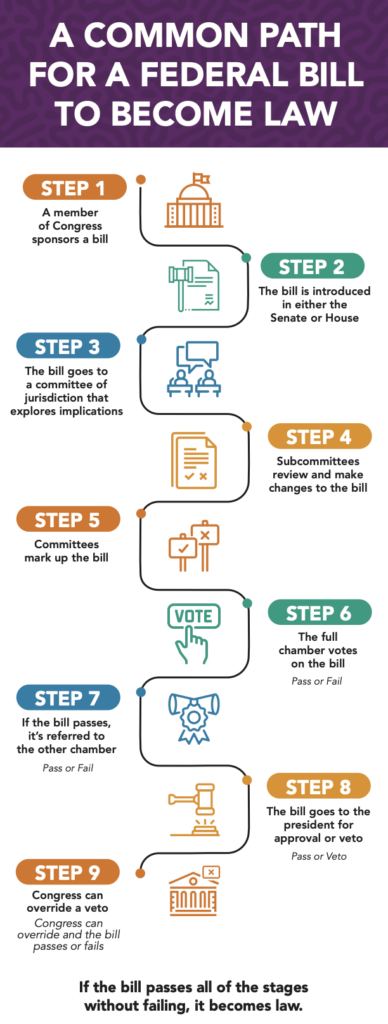Public policy work can be a tricky business. To truly affect change in your community and make an impact, you need to understand the ins and outs of how laws are made. Only then can you advance your issue at the right time and place.
If you’re new to public policy work—or have someone on your team who’s still learning the nuances of government relations—this post can help you get up to speed fast.
Here, we give a quick overview of how a bill becomes a federal law, the key terms you need to know, and some modern tools that are making the necessary legislative tracking—and collaboration among public policy teams—more efficient. (The process is similar on the state level, but each state handles the process slightly differently.)
(To be fair, you could watch Schoolhouse Rock’s “I’m Just a Bill” video, but the dated yet beloved cartoon for elementary school kids doesn’t cover tips for efficiency and digital collaboration.)
A little fine print to keep in mind with the legislation process…
This is how the process is supposed to work in the ideal. Once you get human beings involved, well…things can happen. Bill text can get changed. Sometimes the entire text of another bill can get merged into a piece of legislation without going through the process. (Rarely, even stranger things happen like permanent Daylight Savings passing the Senate unanimously without a full vote).
That’s one reason it helps to have good legislative tracking tools. A good tool will highlight changes that appear through the process, alert you when they happen, and even identify passages of similar text from other bills by using Artificial Intelligence (AI).
And now back to your regularly scheduled blog post.

How a Bill Can Become a Federal Law
Step 1: A member of Congress sponsors a bill
While the ideas for proposed legislation (called a bill) can come from the Senate, House of Representatives, advocacy groups, or everyday citizens, only a member of Congress can introduce, or sponsor, a bill.
Step 2: The bill is introduced in either the Senate or House
You can find federally sponsored bills listed on Congress.gov. Or you can use legislative tracking software to receive automatic notifications of federal and state bills making their way through the legislature. Tracking tools can simplify how you collaborate with your public policy team, allowing you to tag a bill, assign the next action step, or categorize legislation by priority and policy stance.
Step 3: The bill goes to a committee that explores implications
Both the upper chamber (Senate) and lower chamber (House) have various committees made up of members who are responsible for issues such as health, commerce, or foreign affairs. (Fun fact: Nebraska is the only state to have a single chamber.) Legislative tracking software can also help you see which bills are gaining traction and more likely to come up for a vote, enabling your team to devote resources to legislation that will have an impact.
Step 4: Subcommittees review and make changes to the bill
Often, committees vote to refer bills to a subcommittee that further studies the bill. The subcommittee conducts hearings and “marks up” the bill–essentially edits or amends it–before voting to move the bill forward and reporting back to the committee on their findings.
Step 5: Committees mark up the bill
When the hearings are completed, the committee will make additional changes and amendments prior to a vote recommending the bill to the “floor,” which refers to the physical place where members debate, vote, and conduct other legislative business.
Step 6: The full chamber votes on the bill
With some exceptions, bills can originate in either chamber. For a bill to become a law, it has to first pass the chamber in which it originates and then pass the other chamber. Once the bill reaches the floor, members debate the bill, approve any amendments, and vote whether to pass it. If it doesn’t get enough votes, the bill dies.
Step 7: If the bill passes, it’s referred to the other chamber
Because each chamber may pass different versions of the same bill, Congress may have a conference committee to resolve or reconcile the differences. If the conference committee is unable to reach an agreement, the bill dies.
Step 8: The bill goes to the president or governor for approval or veto
If both the House and Senate approve a bill in identical form, it’s sent to the President. If approved, the president signs the bill and it becomes a law. If opposed, the president vetoes it.
Step 9: Congress can override a veto
If the President vetoes a bill, the veto can be overridden by getting the Senate and House to pass the bill by a two-thirds majority.
Of course, this is only one possible path. To get more details and learn about alternative paths, we highly recommend you review the articles and videos here.
Key Terms to Understand in Legislation
Knowing the definitions of bill, law and legislation will help you stay on top of where key bills are in the legislative process so your public policy team can decide on strategies.
Bill
Proposed legislation that is under consideration by a legislature.
Congress
Congress is the legislative arm of our government and its job is to make laws. Congress is made up of two houses: the Senate (upper) and the House of Representatives (lower).
Law
Once a bill has been enacted into law, it is called a statute or a law.
Legislation
The action of legislating or exercising the power and function of making a bill into a law.
Lobbyist
A person who takes part in an organized attempt to influence legislators.
Government Relations
The process of influencing public policy at all levels of governance: local, regional, national, and even global.
House of Representatives
One half of Congress. The number of representatives a state has is determined by its population. Each representative serves two-year terms.
Public Policy
A system of laws, regulatory measures, courses of action, and funding priorities concerning a given topic promulgated by a governmental entity or its representatives.
Senate
The other half of Congress. Each state has two senators in the Senate who serve six-year terms.
Manage All the Moving Parts
Now that you’re up to speed (we won’t tell if you bookmark this post as a reference), it’s time to take the next step: see how you can streamline tracking bills and collaborating on issues with legislative tracking technology.

